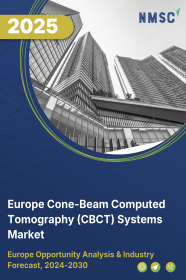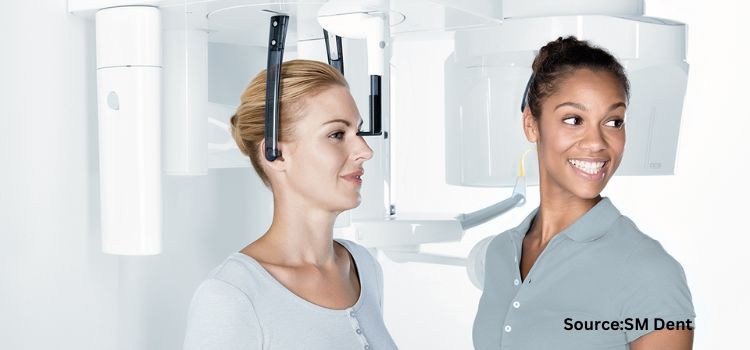
Europe Cone-Beam Computed Tomography (CBCT) Systems Market by Patient Position (Seated, Supine, and Standing), by Detector Type (Image Intensifier and Flat-Panel Detector), by Field of View (Small FOV Systems, Medium FOV Systems, and Large FOV Systems), by Application (Dental, ENT Applications, Orthopedic Conditions, Neural & Spine, Lung Cancer, and Veterinary) and by End User (Dental Clinics, Hospitals, and Others) – Opportunity Analysis and Industry Forecast, 2023–2030
Industry: Healthcare | Publish Date: 04-Mar-2025 | No of Pages: 171 | No. of Tables: 138 | No. of Figures: 106 | Format: PDF | Report Code : HC811
US Tariff Impact on Europe Cone-Beam Computed Tomography (CBCT) Systems Market
Trump Tariffs Are Reshaping Global Business
Market Definition
Europe Cone-Beam Computed Tomography (CBCT) Systems Market was valued at USD 300.4 million in 2022 and is predicted to reach USD 741.11 million by 2030, with a CAGR of 11.05% from 2023 to 2030.
Cone Beam Computed Tomography (CBCT) also known as C-arm CT, cone beam volume CT, flat panel CT, or Digital Volume Tomography (DVT), Digital Volume CT which is a specialized medical imaging technique used to create three-dimensional images of various structures within the human body.
It utilizes a cone-shaped X-ray beam that rotates around the patient, capturing a series of two-dimensional X-ray images from different angles.
These images are then reconstructed by a computer to generate detailed 3D representations of the scanned area. CBCT technology is commonly used in dentistry, oral and maxillofacial surgery, and orthodontics, providing a comprehensive view of the teeth, jaws, facial bones, and surrounding tissues.
By capturing images with high spatial resolution and minimal distortion, CBCT allows healthcare professionals to visualize anatomical structures with great precision and accuracy.
The advantages of CBCT over traditional medical imaging techniques, such as conventional X-rays or CT scans, include lower radiation exposure, shorter scan times, and the ability to produce high-quality 3D images.
This technology enables healthcare providers to plan and perform complex dental and surgical procedures more effectively, facilitating accurate diagnosis, treatment planning, and evaluation of treatment outcomes.
Thus, CBCT is an advanced imaging technique that employs cone-shaped X-ray beams and computer algorithms to generate detailed three-dimensional images of the human body, primarily used in dental and maxillofacial applications for improved diagnosis and treatment planning.
Government Initiatives and Dental Tourism Drive Growth of CBCT Market in Europe
Governments in European countries have implemented favorable initiatives and policies to promote oral health and advance dental care. This includes increased funding for dental healthcare infrastructure, reimbursement schemes, and awareness campaigns highlighting the benefits of advanced diagnostic technologies including CBCT. Such support from governments has stimulated the growth of the CBCT market in Europe.
Additionally, Europe attracts a significant number of dental tourists who seek high-quality dental treatments at a lower cost.
CBCT imaging plays a crucial role in providing accurate diagnosis and treatment planning for these international dental tourists, further boosting the demand for CBCT systems in the region.
Digital Dentistry Advancements Fuel the Expansion of the CBCT Market in Europe
The increasing awareness and adoption of digital dentistry practices in Europe are pivotal factors driving the growth of the Cone-Beam Computed Tomography (CBCT) market.
CBCT technology plays a crucial role in digital dentistry workflows by delivering precise measurements, digital models, and facilitating virtual treatment planning. As a growing number of dental professionals in Europe embrace digital dentistry for its precision and efficiency, the demand for CBCT systems has surged, underlining their essential role in modern dental practices across the region.
High Cost of Cone-Beam Computed Tomography (CBCT) Systems Machines in Europe
The high cost of Cone Beam Computed Tomography (CBCT) machines can act as a significant restraint on the growth of the CBCT market.
The initial investment required for acquiring CBCT machines is substantial, which can be a deterrent for healthcare facilities, particularly smaller clinics or practices with limited budgets. The high cost not only includes the purchase of the machine itself but also factors in installation, maintenance, and training costs.
The financial burden associated with CBCT machines can limit their adoption, especially in regions with resource constraints or in healthcare settings where budget allocations are tight. This can restrict the availability and accessibility of CBCT technology, hindering its widespread implementation in various healthcare facilities.
Technological Advancements in CBCT Systems Market in Europe: A Promising Opportunity for Growth
The integration of Artificial Intelligence (AI) in CBCT software has the potential to revolutionize the field of imaging and significantly enhance the capabilities of CBCT technology.
With AI algorithms, CBCT software can analyze and interpret images with greater precision and efficiency. These algorithms can be trained to automatically detect and segment anatomical structures, lesions, and abnormalities, providing valuable insights to clinicians.
By automating these tasks, AI integration can save time and improve diagnostic accuracy, ultimately leading to more effective treatment planning.
Additionally, AI-powered CBCT software can simulate and visualize treatment outcomes, enabling clinicians to better plan and communicate treatment options with patients.
Whether it's virtual implant placement, orthodontic treatment simulations, or surgical planning, the integration of AI in CBCT software offers new possibilities for personalized and optimized patient care. It holds the promise of streamlining workflows, reducing manual labor, and enhancing the overall efficiency and precision of CBCT imaging in various medical and dental applications.
Competitive Landscape
The Europe cone-beam computed tomography (CBCT) systems industry includes several market players such as Dentsply Sirona, Koninklijke Philips N.V., Vatech Co., Ltd, Envista Holdings, Planmeca OY, J. Morita Mfg. Corp., Cefla S.C., Hefei Meyer Optoelectronic Technology INC, Xoran Technologies LLC, Acteon Group, Hitachi Ltd., Genoray Co Ltd, Asahi RoEntgen Ind. Co. Ltd., OSSTEM IMPLANT CO., LTD., Largev Instrument Corp. Ltd., Carestream Dental LLC, Curvebeam AI, and HDXWILL.
Key Benefits
-
The Europe cone-beam computed tomography (CBCT) systems market report provides a quantitative analysis of the current market and estimations through 2023-2030 that assists in identifying the prevailing market opportunities to capitalize on.
-
The study comprises a deep dive analysis of the market trend including the current and future trends for depicting the prevalent investment pockets in the industry.
-
The information related to key drivers, restraints, and opportunities and their impact on the market is provided in the report.
-
The competitive analysis of the key players along with their market share in the Europe cone-beam computed tomography (CBCT) systems market.
-
The SWOT analysis and Porter’s Five Forces model are elaborated in the study.
-
Value chain analysis in the market study provides a clear picture of the stakeholders’ roles.
Europe Cone-Beam Computed Tomography (CBCT) Systems Market Key Segments
By Patient Position
-
Seated
-
Supine
-
Standing
By Detector Type
-
Image Intensifier
-
Flat-Panel Detector
By Field of View
-
Small FOV Systems
-
Medium FOV Systems
-
Large FOV Systems
By Application
-
Dental
-
ENT Applications
-
Orthopedic Conditions
-
Neural & Spine
-
Lung Cancer
-
Veterinary
By End User
-
Dental Clinics
-
Hospitals
-
Others
By Geography
-
Europe
-
U.K.
-
Germany
-
France
-
Italy
-
Spain
-
Netherlands
-
Denmark
-
Finland
-
Norway
-
Sweden
-
Russia
-
Rest of Europe
-
Key Players
-
Dentsply Sirona
-
Koninklijke Philips N.V.,
-
Vatech Co., Ltd
-
Envista Holdings
-
Planmeca OY
-
J. Morita Mfg. Corp.
-
Cefla S.C.
-
Hefei Meyer Optoelectronic Technology INC
-
Xoran Technologies LLC
-
Acteon Group
-
Hitachi Ltd.
-
Genoray Co Ltd
-
Asahi RoEntgen Ind. Co. Ltd.
-
OSSTEM IMPLANT CO., LTD.
-
Largev Instrument Corp. Ltd
-
Carestream Dental LLC
-
Curvebeam AI
-
HDXWILL
REPORT SCOPE AND SEGMENTATION:
|
Parameters |
Details |
|
Market Size in 2022 |
USD 300.4 Million |
|
Revenue Forecast in 2030 |
USD 741.11 Million |
|
Growth Rate |
CAGR of 11.05% from 2023 to 2030 |
|
Analysis Period |
2022–2030 |
|
Base Year Considered |
2022 |
|
Forecast Period |
2023–2030 |
|
Market Size Estimation |
Million (USD) |
|
Growth Factors |
Increased government initiatives
The increasing awareness and adoption of digital dentistry practices |
|
Countries Covered |
11 |
|
Companies Profiled |
18 |
|
Market Share |
Available for 18 companies |
|
Customization Scope |
Free customization (equivalent up to 80 working hours of analysts) after purchase. Addition or alteration to country, regional, and segment scope. |
|
Pricing and Purchase Options |
Avail customized purchase options to meet your exact research needs. |

















 Speak to Our Analyst
Speak to Our Analyst





















